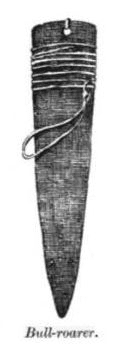Music is often called the world’s universal language. No matter where somewhere may be from, everyone seems to understand the feelings that music evokes. While we may never know for sure when our ancestors first developed music, we do know that some of the earliest examples of musical instruments appeared over 40,000 years ago.
These findings suggest that the early modern humans who first settled in Europe already had musical traditions — it is believed that they created their instruments soon after they settled in Europe.
Our ancestors may have developed music about 50,000 years ago, during the “cultural explosion”, the time period when humans began creating art, jewelry, ceremonially burying the dead.
8. Tutankhamun’s Trumpets
Age: about 3,340 years old
Country of Origin: Egypt
Material(s) Used: One with sterling silver, the other from bronze or copper
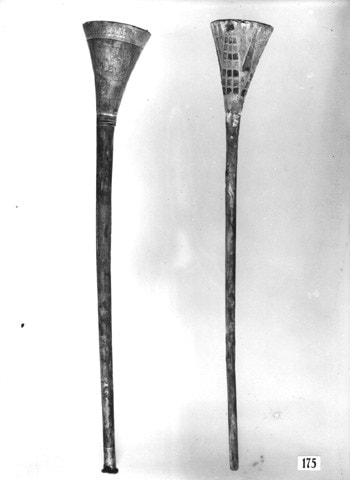
The pair of trumpets from Pharaoh Tutankhamun’s tomb are believed to be the oldest playable trumpets in the world. These trumpets are the only ones that have survived from ancient Egypt and are over 3,000 years old. They were discovered in 1922 by archaeologist Howard Carter during an excavation of Tutankhamun’s tomb.
Both trumpets feature finely engraved decorative images of the god Ra-Horakhty, Ptah, and Amun.
In 1939, the trumpets were played before a live audience and the performance was broadcast internationally through BBC radio. Since their discovery, there have been claims that the trumpets have the power to summon war.
People have connected the British entering World War II with the trumpets because the war in Europe started five months after the BBC broadcast.
7. Jiahu Flutes
Age: 7,000 – 9,000 years old
Country of Origin: Jiahu, Yellow River Valley, China
Material(s) Used: Red-Crown Crane wing bones
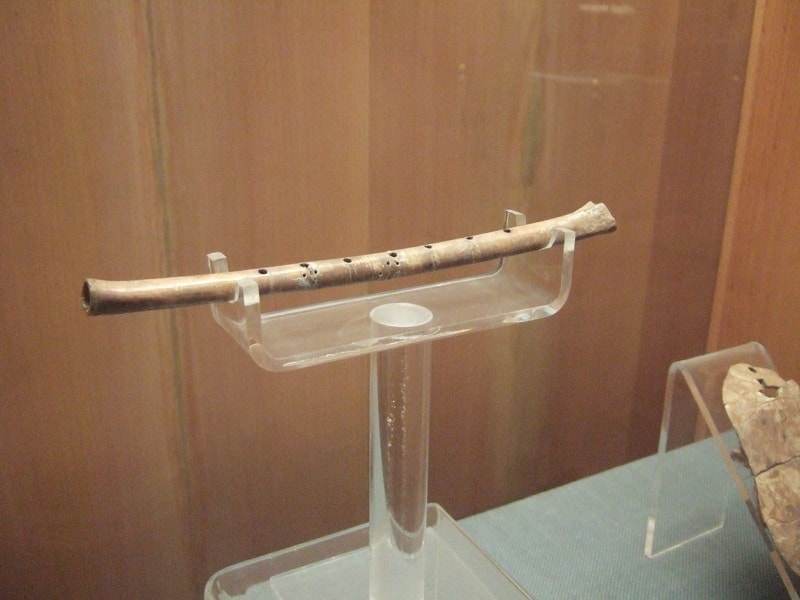
The bone flutes discovered at the Jiahu archaeological site are the oldest known musical instruments from China. Thirty-three flutes in various states were uncovered at the site — about 20 of the flutes are intact and the rest are broken or fragmented. Six of the flutes are complete and are considered to be the oldest playable, multi-note musical instruments ever found.
The flutes vary in size and have five, six, seven, or eight holes.
Researchers have played the best-preserved flute and have uploaded audio recordings that showcase musical signs that are thousands of years old.
Tonal analysis revealed that the seven-holed flute produces notes similar to the familiar Western eight-note scale that begins with “do, re, mi.”
6. Lithophones
Age: between 4,000 and 10,000 years old
Country of Origin: Different parts of the world; oldest examples from India and Vietnam
Material(s) Used: Resonant rocks
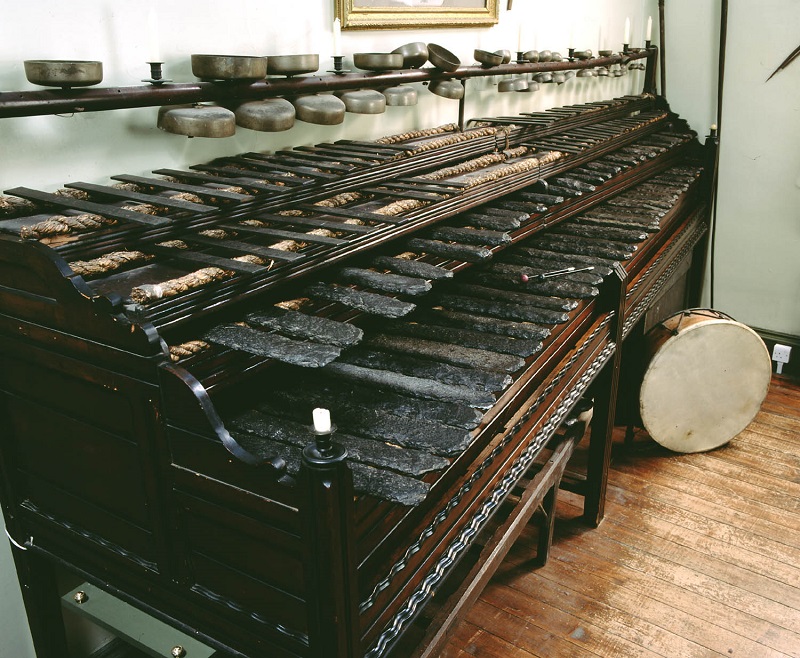
The name “lithophone” is used for any musical instruments made of rocks that produce musical notes when struck. These types of ancient instruments have been uncovered around the world, with some of the oldest known examples coming from Vietnam. The lithophones from Vietnam are called Dan Da and consist of 11 large stone slabs, positioned vertically close to one another.
Researchers determined that the stones were chiseled and could produce music by hitting them.
One of the best-known examples of lithophones are the Musical Stones of Skiddaw. Over two centuries, a series of lithophones were built around the town of Keswick in northern England.
5. Bullroarer
Age: about 20,000 years old
Country of Origin: Different parts of the world; oldest examples from Ukraine and France
Material(s) Used: Thin slat of wood and cord
photo source: Wikimedia Commons
The bullroarer is a ritual musical instrument used by many ancient and current cultures around the world. Historically, it was used for communicating over long distances.
The oldest known example of a bullroarer was found in Ukraine, dating back to the Paleolithic period (about 18,000 BCE). In addition to the oldest bullroarer from Ukraine, archaeologists have uncovered ancient bullroarers in other parts of Europe, Asia, Africa, the Indian sub-continent, Australia, and the Americas.
Although several cultures have used the bullroarer, Australian Aborigines are best known for using the instrument. Aborigines use the bullroarer in initiation ceremonies, in burials to ward off evil spirits, and against bad omens.
4. Isturitz Flutes
Age: 20,000 – 35,000 years old
Country of Origin: Isturitz Cave, France
Material(s) Used: Vulture Wing Bones

The flutes found at the Isturitz archaeological site in southwestern France range in age from about 20,000 to 35,000 years old. Fragments from more than 20 separate flutes were uncovered at the site. The flutes were made by various cultures that lived in the area including Aurignacian, Gravettian, and Magdalenian.
While most of the flutes are in pieces, two of the most complete flutes were created by the Gravettian culture and are between 22,000 and 28,000 years old.
These flutes are well-crafted and show obvious signs of use, especially around the finger holes. The area around the finger holes look polished, which has been interpreted as wear from playing.
3. Hohle Fels Flute
Age: 35,000 – 40,000 years old
Country of Origin: Hohle Fels Cave, Baden-Württemberg, Germany
Material(s) Used: Griffon Vulture Bone
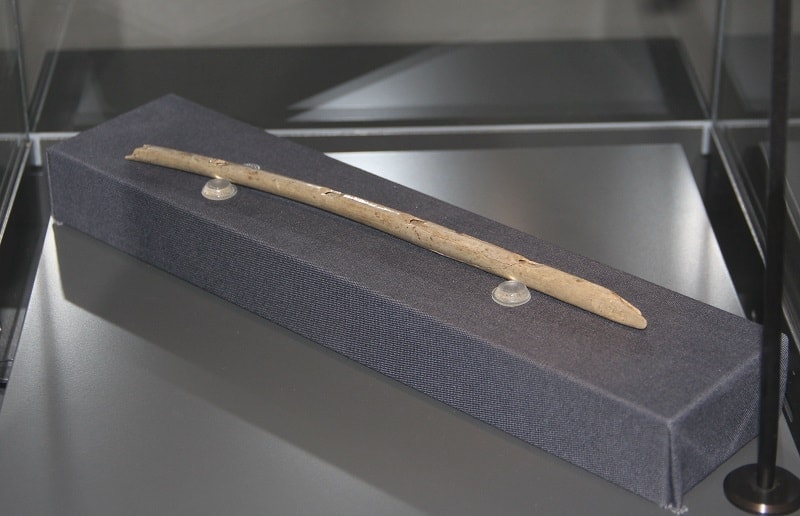
The flute from the Hohle Fels cave was discovered in the fall of 2008 and is between 35,000 to 40,000 years old. Of all the ancient bone flutes uncovered so far, the one from Hohle Fels is the most complete and closely resembles a modern-day flute. The instrument is about 8.5 inches long and the part of the instrument where the musician blew into is still in tact.
Archaeologists say that this flute and the others found in the region “demonstrate the presence of a well-established musical tradition at the time when modern humans colonized Europe.”
A few years ago, Wulf Hein, an “experimental archaeologist”, made a replica of the flute and used it to play The Star-Spangled Banner.
2. Divje Babe Flute
Age: 43,100 years old
Country of Origin: Cerkno, Slovenia
Material(s) Used: Cave Bear Femur
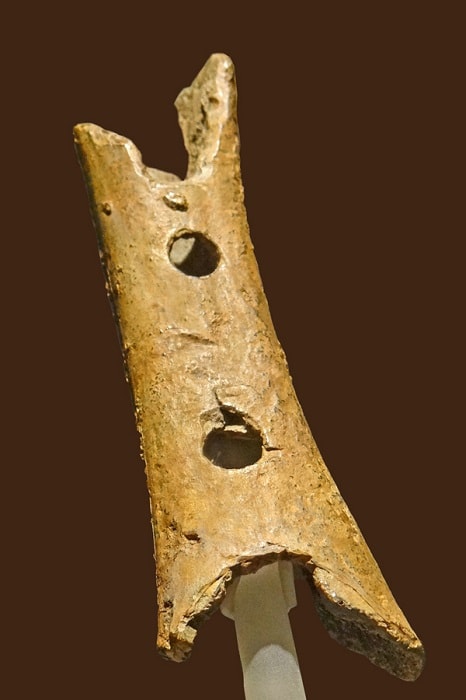
Prior to the discovery of older bone flutes, the Divje Babe Flute was considered the oldest example of a musical instrument ever found in the world. Over the years the flute has drawn differing opinions over who made the flute and whether or not its actually a man-made object in the first place.
Some archaeologists believe that the flute was made by Neanderthals while others have suggested that it was made by Cro-Magnons.
In 2015, a new study was released stating that the flute was actually just a bone chewed up by hyenas. If the findings in the study are true, there is now no existing evidence that Neanderthals possessed the knowledge to make musical instruments.
Despite the new findings, the flute is currently displayed in the National Museum of Slovenia as a Neanderthal flute.
1. Geisenklösterle Flutes
Age: 42,000 – 43,000 years old
Country of Origin: Geisenklösterle Cave, Blaubeuren, Germany
Material(s) Used: Mute Swan bone and Mammoth Ivory

The three flutes found at the Geisenklösterle Cave archaeological site are the oldest instruments in the world. Two of the flutes are made from the bones of mute swans and the other flute is made from mammoth ivory. Researchers have radio carbon dated the flutes and estimate that they are between 42,000 and 43,000 years old artifacts.
The flutes are linked to the Aurignacian, an archaeological culture associated with the earliest modern humans in Europe.
Some researchers believe that these flutes, and other early musical instruments, helped large groups of early humans develop and maintain strong bonds. They believe that these bonds helped our species expand its territories further than the more conservative Neanderthals, who went extinct in most parts of Europe about 30,000 years ago.
OTHER POSTS YOU MAY BE INTERESTED IN



